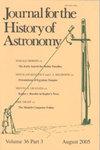Stellar movements and working hypotheses: A.S. Eddington’s early astronomical career
IF 0.3
3区 哲学
Q3 HISTORY & PHILOSOPHY OF SCIENCE
引用次数: 0
Abstract
Arthur Stanley Eddington (1882–1944) was one of the leading astrophysicists of the first half of the 20th century. He is remembered today chiefly for his research into stellar structure and general relativity, both of which he began to explore in the mid-1910s. He was also a key participant in the famous eclipse expeditions of 1919 that tested Einstein’s theory of gravity. Rather than consider these topics, in this paper I will instead examine Eddington’s early astronomical career, that is, from 1906 to about 1915. In this period, he became a well-trained practical astronomer. Eddington also established himself as a brilliant theoretical astronomer, and in so doing helped to create the role of theoretical astrophysicist through his research into star streaming. He was also, unusually for astronomers of this period, an enthusiastic advocate of the use of “working hypotheses” as crucial tools in astronomical practice. The study of Eddington’s early career therefore has much to tell us about the nature of astronomy in the years around 1910 and about Eddington. The paper underlines, for example, the continuing relevance of the “Greenwich-Cambridge Axis” for the power structure of British astronomy, and the importance of the so-called Sidereal Problem for astronomers at this time even though today it is largely forgotten.恒星运动和工作假设:A.S.Eddington早期的天文学生涯
亚瑟·斯坦利·爱丁顿(1882-1944)是20世纪上半叶最杰出的天体物理学家之一。他今天被人们铭记的主要原因是他对恒星结构和广义相对论的研究,这两项研究他都是在20世纪10年代中期开始探索的。他也是1919年著名的日食探险队的主要参与者,该探险队测试了爱因斯坦的引力理论。在本文中,我将不考虑这些主题,而是考察爱丁顿早期的天文生涯,即1906年至1915年左右。在这一时期,他成为了一名训练有素的实用天文学家。爱丁顿还将自己确立为一位杰出的理论天文学家,并通过对恒星流的研究,帮助创造了理论天体物理学家的角色。对于这一时期的天文学家来说,他也是一位热情的倡导者,主张将“工作假设”作为天文实践中的重要工具。因此,对爱丁顿早期职业生涯的研究可以告诉我们1910年前后天文学的本质以及爱丁顿的情况。例如,这篇论文强调了“格林尼治-剑桥轴”对英国天文学权力结构的持续相关性,以及所谓的Sidereal问题对天文学家的重要性,尽管今天它基本上被遗忘了。
本文章由计算机程序翻译,如有差异,请以英文原文为准。
求助全文
约1分钟内获得全文
求助全文
来源期刊

Journal for the History of Astronomy
地学天文-科学史与科学哲学
CiteScore
0.50
自引率
25.00%
发文量
44
审稿时长
>12 weeks
期刊介绍:
Science History Publications Ltd is an academic publishing company established in 1971 and based in Cambridge, England. We specialize in journals in history of science and in particular history of astronomy.
 求助内容:
求助内容: 应助结果提醒方式:
应助结果提醒方式:


